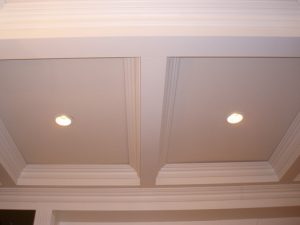Setting up recessed lights properly means distributing them appropriately. However, there’s no right or correct measurement. It is entirely up to the lighting needs of the room. Kitchens and study rooms need more lumen compared with a playroom for example.
Some Suggestions
First, think of the room’s functionality. Suppose you want to light up the TV room. Wall washers can be used for indirect lighting. This can subdue the overhead light. What this means is you don’t have to darken everything when watching TV. The important thing is to set up the dimmers, placements and switches in the right places.
If you’re using down lights, ¾ or 1x the space between the ceiling and the lit area would be sufficient. If the ceiling is 8’, that means setting up recessed lights 6 to 8’ apart. If you’re going to use wall washers, install the lights 1/5 from the wall height. Orient it about ¼ downwards.
If you want the flooded light look, the space needs to be ¼ of the height. If you’d rather have spot lights, distribute them at ½. If the overhead light is too strong, use 4” cans.
A Sample Layout
Assume the recessed can is 40 watts with an R 40 flood (60 deg is the beam cast). If the roofing is 8 ft high, the full light extends to 9 ft. if you’re setting up recessed lights like this, the most intense point is 5 ft. Beyond that the light will dissipate.
Is this setup adequate? It depends on its use. If it’s the living room, it would be enough. The illumination would be quite sufficient. Having dimmers and switches is also preferred. It will help illuminate certain sections.
This setting is also applicable for 9 ft high ceilings. In both 8 and 9 ft high ceilings, no more than 6 ft space between the lights is recommended.
If you need more illumination, place the lights 4 to 5 ft distance. This should be sufficient for reading and other tasks. At intervals of 5 ft, the initial light needs to be 30” from the wall.
Setting up Recessed Lights Yourself
Shut down the power and place the joists with the stud finder on the ceiling. Use the template to shape the opening. Cut it with a saw. Set the wire from the power source. Put the cable at the junction box.
Take off the insulation and combine it with the house wiring. Use the colorings as a guide. White lamp wire goes with white cabling, black with black and the green with the ground cabling.
Put the junction box in the opening. Secure it in place with a screw. Follow the instructions in your lighting kit to finish the installation. Follow the instructions to the letter to avoid problems. Of course you should be careful when handling wires.
The key to setting up recessed lights is good spacing and planning. Think of how you’ll utilize the room when laying everything out. Always keep that in mind and you’ll end up with a pleasing lighting arrangement.

